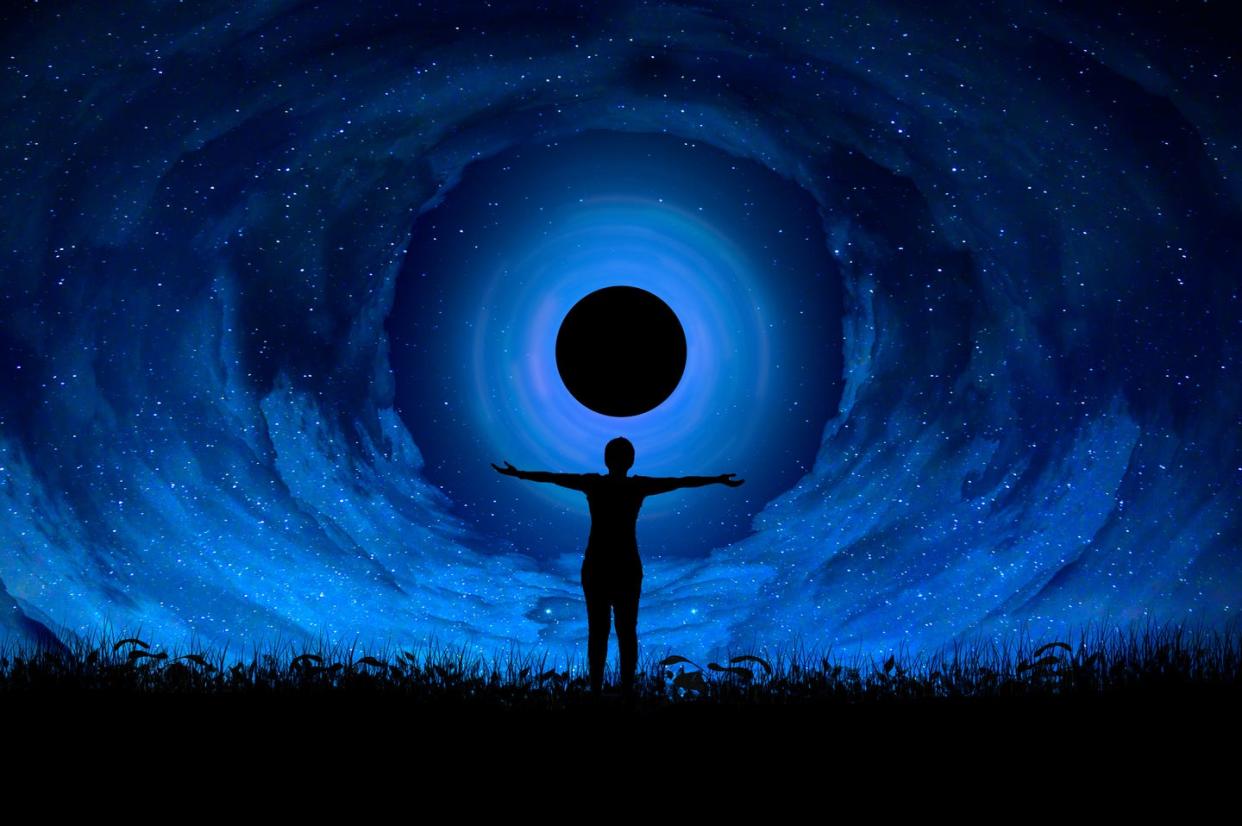Scientists Say Wormholes Are Secretly Altering Our Reality

Churning nano-wormholes could explain the clash in our cosmological constants.
The wormholes add magnitude to a math parameter called the Gauss-Bonnet term.
Boosting one term in a complex equation helps scientists explain how the results could change.
Scientists in Greece have laid out a mathematical framework to help explain a so-far-unsolved gap in our understanding of how gravity scales up to the full size of our universe.
Specifically, cosmologists can’t yet account for how expansion of the universe increased in the “recent cosmological past”—a very relative term—because all attempts to quantify the change so far end up clashing with existing mathematical models. The Greek scientists suggest something particularly squiggly: microscopic wormholes, whose nature and density could fill up the missing pieces. These spacetime Orbeez require only a bit of fine-tuning from theories that are already in the zeitgeist.
In the new paper, which appears in the peer-reviewed journal Physical Review D from the American Physical Society, the authors explain that the “positive cosmological constant” meant to quantify our expanding universe has, instead, created math issues: “[Q]uantum field theoretical analysis predicts a value up to 120 orders of magnitude larger than the observed one.”
An order of magnitude is not simply a 1:1 multiplier, so 120 orders of magnitude is likely far more than 120 times larger. But if your lifetime likelihood of being struck by lightning is about 1 in 15,300, 120 times larger jumps to 1 in 127.
If we want to balance the two possibilities, the scientists explain, we need to add at least one new complicating factor. The two main suggestions for this are, first, a changing cosmological constant explained by the idea of dark energy; or second, to deepen our theory of how gravity behaves on the cosmic scale, from a smooth background to a craggier, fjord-like complexity.
This paper suggests combining both options: What if the solution is a believably craggier background gravity covered with instantons and wormholes, and their more rugged landscape naturally accounts for an amount of dark energy as well?
Let’s define some terms. When cosmologists try to model the universe, they break it down using practices like topology and manifold theory. They build in as many variables or ideas as they have at the time, leaving spaces where something is not yet known. And, just like in your high school calculus class, the goal is always to account for everything on both sides of any equal sign or other equivalence in your mathematical model.
The physics of different scales simply don’t match easily yet. Concrete observations by Albert Einstein and those before turned into beautiful theories that account for the visible world and parts of outer space; quantum mechanics twists those pieces until they no longer fit together into a completed puzzle. Considering spacetime as a manifold, or a surface that is guided by interlocking math on a grand scale, lets physicists look for the correct new place for a particular piece of the puzzle.
One way spacetime acts up is called quantum foam. On an extraordinarily tiny level, scientists believe, even quantum phenomena break down and create tiny bubbles where principles no longer apply. If someone can be a writer’s writer or a comedian’s comedian, this is kind of the disruptive quantum mechanics of quantum mechanics. And it’s in this foam where wormholes could exist in a way that brings cosmic ideas together without breaking any larger rules.
The term “wormhole” may even be misleading, because they can be tunnels, but may also simply be punched holes that cross through higher dimensions behind the scenes. Manifold theory allows scientists to add these dimensions and at least attempt to rationalize them, something difficult to do using a three-dimensional human mind.
Once we allow that there could be wormholes in the foam, the scientists explain in the paper, a number of other relevant math operations and transformations build on that foundation. The solution, “an effective cosmological constant,” appears when you apply the Gauss-Bonnet theorem: “[T]he variation of the Gauss-Bonnet term on a manifold that has topology changes due to the formation of wormholes is not zero.”
In astrophysics, that’s a mic drop.
As for where dark energy comes into this, it’s still a part of our working model of the universe, wormholes or not. In this case, the wormholes would directly account for at least some of that dark energy: “[T]he wormhole density in a dynamical spacetime is not expected to be constant, therefore the obtained effective cosmological constant also acquires a dynamical nature, i.e., it corresponds to an effective dark energy sector.”
In other words, the churn of the micro wormholes creates a changing constant. And to account for the observed cosmological constant, all we need is “1016 microscopic wormholes,” or 10 quadrillion, “per cubic meter per second.” That, the scientists conclude, is well within the realm of possibility based on estimates.
You Might Also Like
